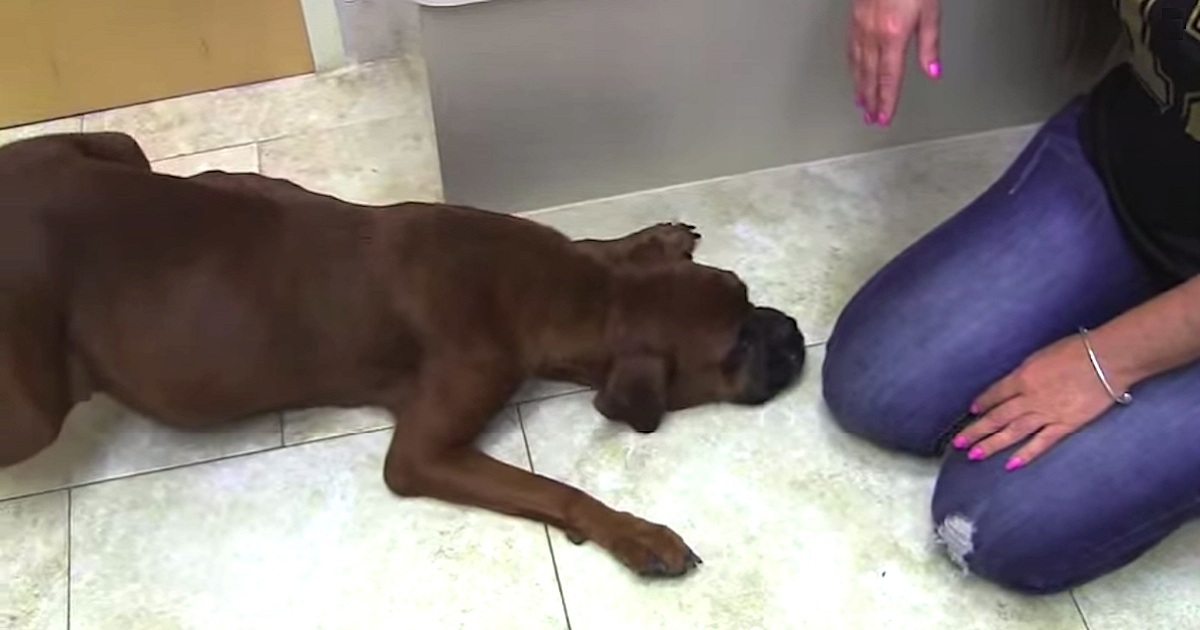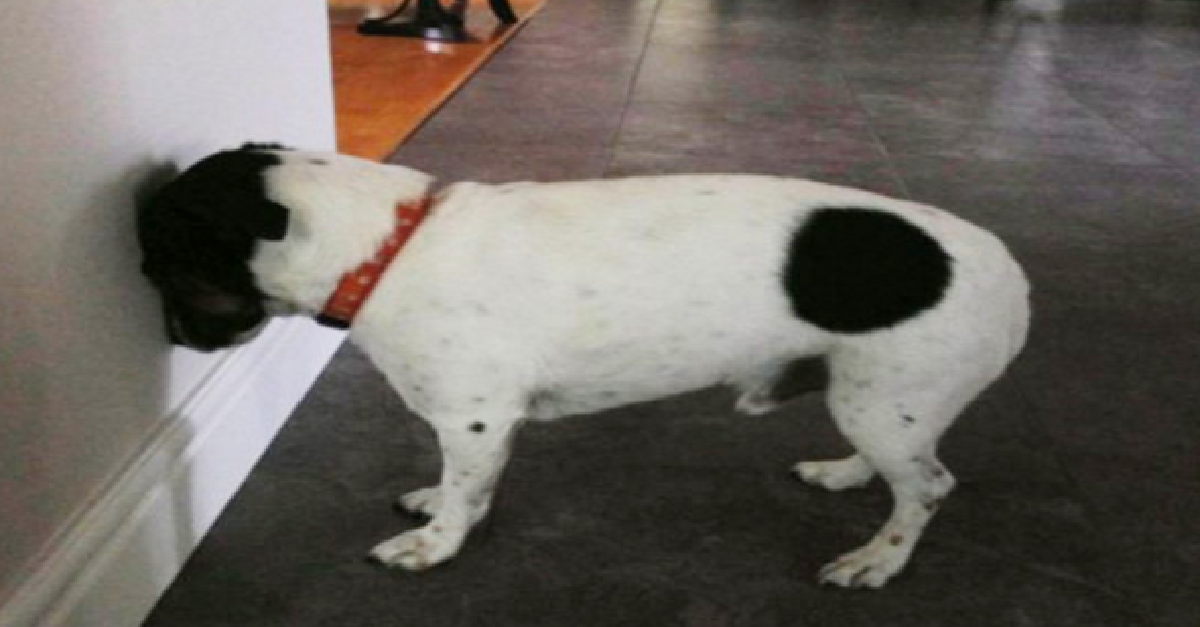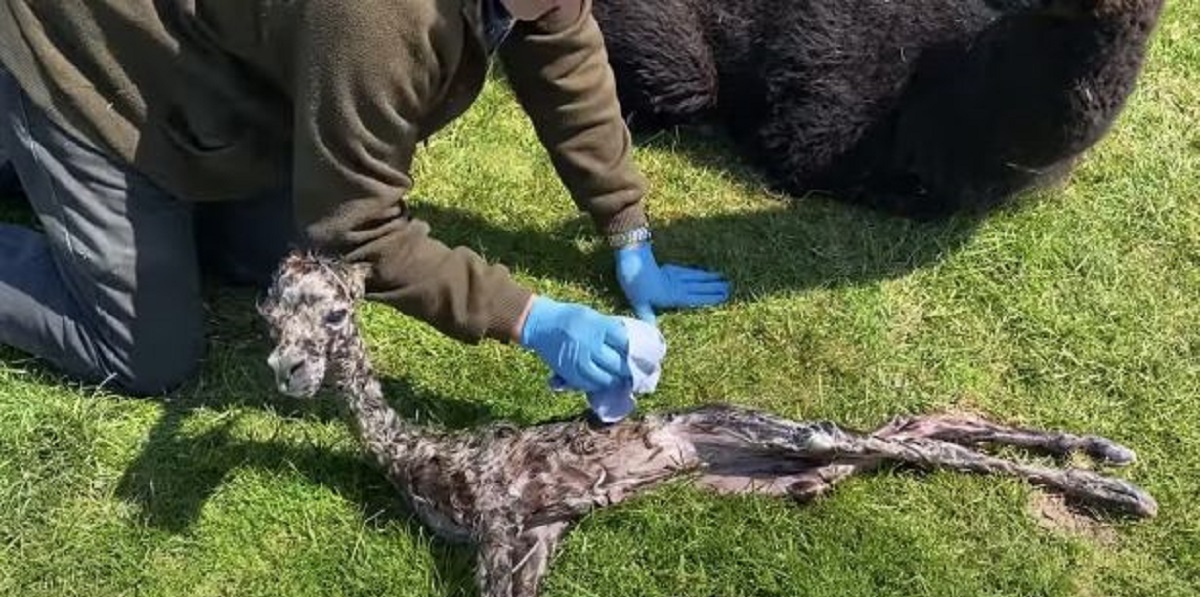Giving your hamster a variety of food options is important for their overall health and well-being. One common question that hamster owners have is whether it is safe to feed rice to their furry friends. In this article, we will explore the topic of rice in a hamster’s diet and provide some guidelines to help you make informed decisions about what to feed your pet.
First and foremost, it is important to note that hamsters can indeed eat rice. Both raw and cooked rice can be safely enjoyed by hamsters, but it should only be given as an occasional treat, rather than a staple in their diet. Rice should never replace the main components of a hamster’s diet, such as nutritional pellets, seeds, fresh vegetables, and fruits.
When it comes to the type of rice to offer your hamster, whole grain rice is a better choice compared to white rice. Whole grain rice contains important nutrients such as B vitamins, fiber, and iron, which can contribute to your pet’s overall health. However, it’s important to remember that rice should only be given in small amounts and should not be the main focus of their diet.
Can Hamsters Eat Rice? Yes, they can, and is definitely all right.
- Rice is safe for hamsters to eat, both raw and cooked.
- Rice should only be given as a treat and not be the main part of a hamster’s diet.
- Whole grain rice is a better nutritional choice for hamsters compared to white rice, but the nutritional content is not as crucial since rice is only given sparingly.
- Other important components of a hamster’s diet include nutritional pellets, seeds, fresh vegetables, and fruits.
- Avoid feeding hamsters almonds, raw potato, chocolate, onion, or kidney beans, as these can be toxic to them.
Uncooked Rice vs. Cooked Rice
Both uncooked and cooked rice can be safely eaten by hamsters, but there are some differences to consider when deciding which one to feed your furry friend.
Uncooked Rice: Uncooked rice is a favorite among hamsters because it is easier for them to store in their cheek pouches. These small pouches located on the sides of their mouth allow them to gather and transport food to their nests. Uncooked rice provides a convenient and enjoyable snack for your hamster.
Cooked Rice: While cooked rice is safe for hamsters, it requires extra caution when preparing. It should not be too moist or overcooked, as it can become stuck in the cheek pockets and potentially lead to health issues. Therefore, it is essential to cook rice properly before offering it to your hamster as a treat.
Whether you choose to feed your hamster uncooked or cooked rice, it is important to keep in mind that rice, in any form, should only be given as an occasional treat. It should not be a significant part of their regular diet, as hamsters require a balanced and varied menu to meet their nutritional needs.
White Rice vs. Whole Grain Rice
When it comes to feeding rice to hamsters, there is often a debate between white rice and whole grain rice. While both options are safe for our furry friends, whole grain rice offers some additional nutritional benefits.
Whole grain or brown rice contains important B vitamins, fiber, and iron. These nutrients are beneficial for hamsters’ overall health and digestion. However, it’s essential to remember that rice should only be given to hamsters as a treat and not as a staple food.
The nutritional value of rice becomes less crucial since it should only be consumed in small amounts. Both white rice and whole grain rice are safe options for hamsters, and they can enjoy them without any issues.
To provide a visual representation of rice varieties, take a look at the image below:
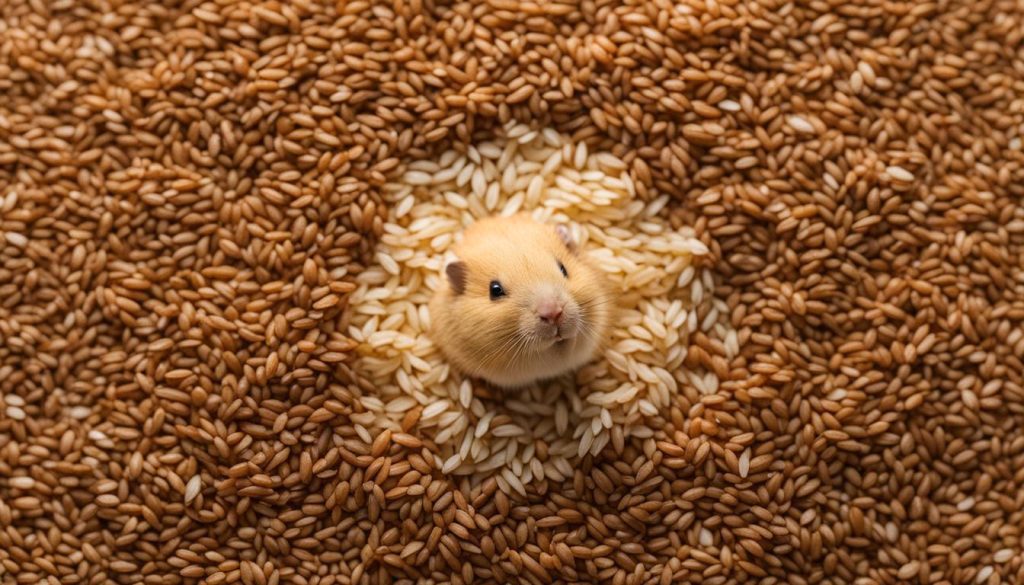
As you can see, hamsters can safely enjoy both types of rice in moderation. However, as a responsible pet owner, it’s important to vary their diet and include other nutritious foods as well.
Other Additions to Your Hamster’s Diet
Aside from rice, there are several other treats and safe foods that you can add to your hamster’s diet to keep them happy and healthy. Variety is important, as it ensures your hamster receives a balanced diet.
One popular treat for hamsters is cottage cheese. It provides a good source of protein and can be given in small amounts as an occasional treat. Just be sure to choose a plain variety without added sugars or flavors.
Similarly, small pieces of fruit can be added to your hamster’s diet as a sweet and nutritious snack. Apples, bananas, and strawberries are all safe options, but remember to remove any seeds or pits as they can be harmful.
Whole grain pastas, both cooked and uncooked, can also be offered as a treat. Just ensure they are plain and free from added sauces or seasonings.
Bread is another option to consider, but make sure it is a whole grain variety without any sugary toppings or fillings. You can offer small pieces as a special treat.
Additionally, dog biscuits can be a suitable addition to your hamster’s diet. Opt for ones that are specifically formulated for small animals, as they provide a good source of nutrients. Always check the ingredients list to ensure they are free from harmful additives.
A hard-boiled egg can be provided as a source of protein. Remember to remove the shell and cut the egg into small, manageable pieces for your hamster to enjoy.
Finally, dandelion leaves are a safe green option for your hamster’s diet. They can be fed fresh or dried, and make a great addition to their food rotation.
It’s important to avoid cereals with sugar and anything with oil or grease, as these can be detrimental to your hamster’s health. Furthermore, certain foods such as almonds, raw potato, chocolate, onion, and kidney beans should never be fed to hamsters as they are toxic and can cause severe harm.
Remember to always introduce these treats and safe foods gradually, monitoring your hamster for any adverse reactions. Variety and moderation are key to maintaining a balanced hamster diet and keeping your furry friend healthy and happy.
Is Rice Safe for Hamsters?
Rice is a common staple in many human diets, but can it be safely given to our furry friends? The answer is yes – rice is considered safe for hamsters to consume. Whether it’s raw or cooked, rice can be included as a treat, offering a change in flavor and texture to their regular diet.
So, is there a difference between feeding raw and cooked rice to hamsters?
Hamsters have unique cheek pouches that they use for storing and carrying food. Uncooked rice, being dry and lightweight, is easier for hamsters to handle and store in their pouches. On the other hand, cooked rice should be given with caution as it can often be more moist and sticky, which increases the chance of it becoming stuck in their pouches. This can lead to discomfort and potential health issues. It’s important to ensure that cooked rice is properly cooked and not too moist or sticky when offering it to your hamster.
How much rice should you feed your hamster?
Rice, whether raw or cooked, should only be given as a treat and not be the main component of a hamster’s diet. Due to its low nutritional value, it’s important to provide a varied diet that includes other foods such as seeds, nutritional pellets, fresh vegetables, and some fruits. These options offer a greater variety of nutrients that are essential for your hamster’s overall health and wellbeing.
Feeding your hamster a balanced diet is crucial, and it’s important to be aware of any potential risks or toxic foods.
While rice is safe for hamsters, it’s essential to avoid certain foods that can be harmful to them. Some examples include almonds, raw potatoes, chocolate, onions, and kidney beans. These foods may contain substances that are toxic to hamsters and can lead to serious health problems.
Overall, rice can be a safe and enjoyable addition to your hamster’s diet when given in moderation. Whether you choose to feed them raw or cooked rice, always ensure that it is of suitable texture and consistency. Remember, a balanced and varied diet is key to keeping your furry friend healthy and happy.
Health Benefits of Rice
Rice offers some health benefits for hamsters, although the nutritional value may not be significant due to the small amounts they should consume. Brown and whole grain rice have a higher nutritional value compared to white rice because the husks contain important B vitamins, fiber, and iron.
However, it’s important to note that these nutrients are not essential in a hamster’s diet, as they can obtain them from other foods as well.
How to Prepare Rice
When it comes to feeding rice to hamsters, the best option is to serve it raw and uncooked. Hamsters find it easier to store uncooked rice in their cheek pouches, which is a natural behavior for them. However, if you prefer boiling or cooking rice before feeding it to your furry friend, there are a few things to keep in mind.
First, make sure the rice is properly cooked but not too moist or sticky. Sticky rice can get stuck in the hamster’s cheek pouches, potentially leading to health issues. It’s important to maintain the right texture and consistency for safe consumption.
Additionally, you can incorporate rice into homemade treats for your hamster. Try coating a stick in natural honey or peanut butter, rolling it over seeds, and adding a few grains of rice. This way, your pet can enjoy rice as part of a fun and varied treat.
Remember to always prioritize your hamster’s well-being when preparing and serving rice. By following these guidelines, you can provide a safe and enjoyable rice experience for your furry friend.
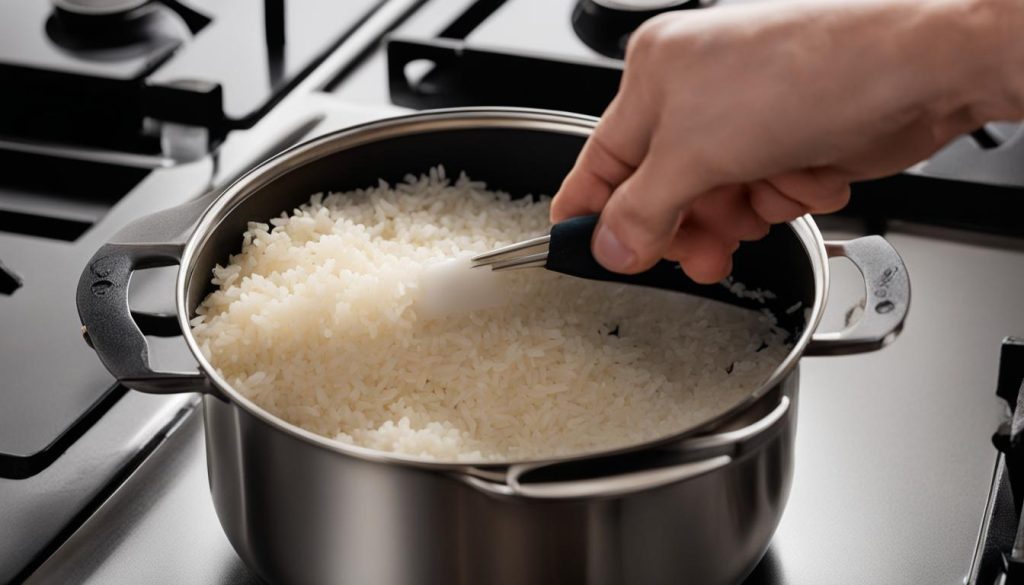
Conclusion
Rice can be included in a hamster’s diet as a treat, both in its raw and cooked forms. It is safe for hamsters to consume, but it should not be the main component of their meals. Whole grain rice is a better nutritional choice due to its higher content of B vitamins, fiber, and iron. However, since rice should only be given sparingly as a treat, the nutritional value is not a crucial factor.
It is important to provide hamsters with a diverse diet that includes other foods such as seeds, nutritional pellets, fresh vegetables, and some fruits. These foods can provide the necessary nutrients to keep your hamster healthy. On the other hand, it is crucial to avoid feeding hamsters almonds, raw potato, chocolate, onion, or kidney beans, as these can be toxic to them.
Remember, the key to maintaining a balanced hamster diet is moderation and variety. Including rice as an occasional treat, along with other nutritious foods, will help keep your furry friend happy and healthy.
FAQ
Can hamsters eat rice?
Yes, hamsters can safely eat both raw and cooked rice, but it should only be given as a treat and not constitute the majority of their meals.
Is rice safe for hamsters to eat?
Rice is considered safe for hamsters, both raw and cooked. However, precautions should be taken to ensure that cooked rice is not too moist or sticky, as it could become lodged in the hamster’s cheek pouches.
Which type of rice is better for hamsters?
Whole grain rice is a better nutritional choice for hamsters than white rice, as it contains important B vitamins, fiber, and iron. However, since rice should only be given as a treat, the nutritional content is not as crucial.
Can hamsters eat other foods besides rice?
Yes, in addition to rice, hamsters can be given treats like cottage cheese, small amounts of fruit, whole grain pastas (cooked or uncooked), bread, dog biscuits, hard-boiled egg, and dandelion leaves. It’s important to avoid cereals with sugar and anything with oil or grease.
Are there any foods that should be avoided when feeding hamsters?
Yes, certain foods such as almonds, raw potato, chocolate, onion, and kidney beans should never be fed to hamsters as they are toxic.
Does rice offer any health benefits for hamsters?
Rice does offer some health benefits for hamsters, but since they should only consume it in small amounts, the nutritional value is not substantial. Whole grain rice has greater nutritional value due to the presence of husks, which contain important B vitamins, fiber, and iron.
How should rice be prepared for hamsters?
The best way to feed rice to hamsters is raw and uncooked, as it is easier for them to store in their cheek pouches. If boiling or cooking rice before feeding, it should be properly cooked but not too moist or sticky.


